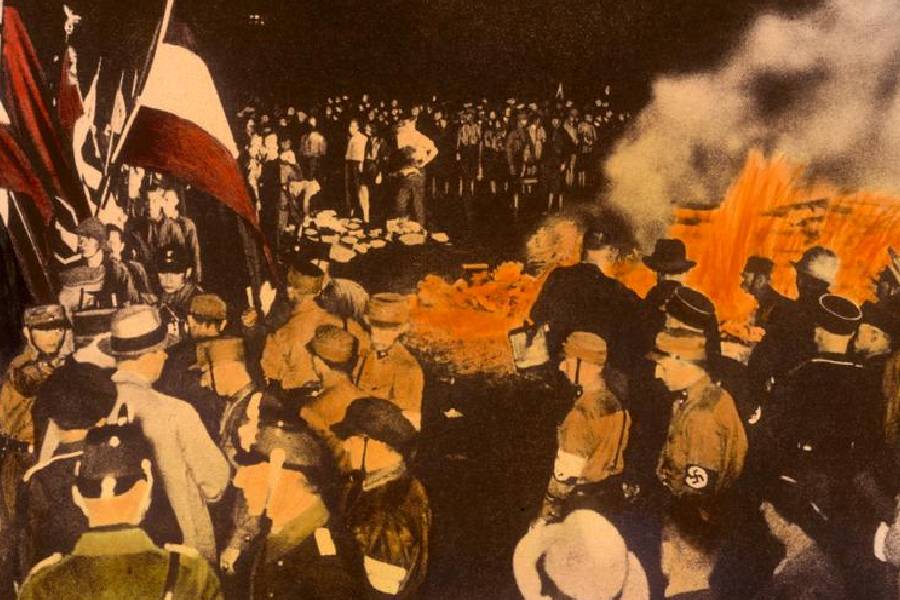On a rainy night in May, German writer Erich Kästner stands among Nazi SA officers and onlookers before a burning pyre that illuminates Berlin's Opernplatz, now called Bebelplatz. Men in black SA uniforms throw piles of books on to the fire. Kästner listens as his name is shouted into a microphone: "Against decadence and moral decay! For discipline and decency in family and state! I hand over to the flames the writings of Heinrich Mann, Ernst Glaeser and Erich Kästner!"
A barbarous act that reverberates to this day
It's the night of May 10, 1933. In Berlin and in 21 other cities in Germany, bonfires are fed with books. It's an act of barbarism that continues to reverberate to this day.
"If there had been no Nazism; if there had been no book-burnings, then certainly the cultural diversity and innovative spirit that had developed in Germany in the 1920s would have continued," says historian Werner Tress, author of several important books on the subject.
But the Nazis' rise to power put a decisive end to the cultural blossoming that Germany experienced during the time of the Weimar Republic (1919 to 1933). And the book burnings on May 10 were an undeniable indication of that.
The Weimar Republic's cultural elite flees
Many of the writers and intellectuals whose books were burned had already left Germany by that point. Alfred Kerr, Bertolt Brecht, the brothers Thomas and Heinrich Mann, the siblings Erika and Klaus Mann, Albert Einstein, Else Lasker-Schüler, Irmgard Keun, Ernst Toller — to name just a few — were among the cultural elite of the Weimar Republic who fled the Nazis. By the time the Nazis seized power and Adolf Hitler became chancellor, on January 30, 1933, it was clear to them that they had no future in Germany.
Enemies of the Nazis: Jews, leftists, liberals
In the years leading up to their seizure of power, the Nazis had already demonstrated their readiness to fight their opponents — which included all Jews, but also any artists who disagreed with them politically. Anyone who did not toe the Nazis' ideological line was defamed as being "un-German," their names and works added to continually updated blacklists.
By May 1933, more than 200 writers had been blacklisted; a year later, more than 3,500 written works had been banned.
Condemned: 'All Quiet on the Western Front'
The Nazis especially despised the novelist Erich Maria Remarque. His 1928 novel "All Quiet on the Western Front" is an unsparing depiction of the horrors of the First World War, and it was first adapted for film by Hollywood in 1930.
German Nazis and conservatives had previously attacked the book and its pacifist message, accusing it of discrediting German soldiers, and when the film version was released in Germany in 1930, SA thugs disrupted screenings and obtained a temporary ban on the movie.
By May 1933, Remarque, too, no longer lived in Germany. He had emigrated to Switzerland shortly before the Nazis seized power in January of that year.
An open letter from a US icon
While Erich Kästner was possibly the only author to witness the burning of his own books on the night of May 10, 1933, the New York Times published an open letter directed at German university students. The German Student Association had been dominated by the Nazis since 1931 and had been instrumental in organizing the book burnings.
"History has taught you nothing if you think you can kill ideas," the letter read. "Tyrants have tried to do that often before, and the ideas have risen up in their might and destroyed them." Those words were composed by Helen Keller, the blind and deaf American writer and activist, whose book, "How I Became a Socialist," was among those to wind up being fed to the flames, along with works by other international writers such as Jack London, Upton Sinclair, Ernest Hemingway, Maxim Gorky, Alexandra Kollontai, Jaroslav Hasek and Sholem Asch, to name just a few.
Kästner recognized among the crowd
Shortly before midnight on May 10, 1933, a young woman at the Berlin book burning on Opernplatz called out, "That's Kästner over there!"
Erich Kästner became "uneasy," as he later wrote. He left the square, but remained in Germany, somehow keeping his head above water over the next years. As a non-Jew, he was able to survive the period until the end of the Nazi dictatorship in 1945.
Persecution and death
Others were not so lucky.
Journalist and novelist Carl von Ossietzky was arrested in 1933 and died in 1938, following years of imprisonment and torture while under guard in a hospital.
The anti-militarist journalist Erich Mühsam was murdered in 1934 in the Oranienburg concentration camp.
And the German-Jewish poet Gertrud Kolmar, who stayed in Berlin to look after her father, died in 1943 in the Auschwitz extermination camp.
Those who managed to go into exile abroad had to start new lives, often in a new language. For many, that spelled the end of their writing careers, as in the cases of Irmgard Keun, author of the 1932 novel "The Artificial Silk Girl," and Alfred Döblin, who wrote "Berlin Alexanderplatz" (1929).
Others were driven to suicide by psychological or financial hardship, or by the horrors of escaping — such as Walter Benjamin, Stefan Zweig and Ernst Toller.
Success in exile
Only a few émigrés from Europe's cultural scene were able to continue their careers, such as Fritz Lang, Billy Wilder, Bertolt Brecht and Thomas Mann.
"The influx of immigrants from Germany was a huge boon to the American universities and cultural institutions," says historian Tress, "one they still benefit from to this day. But I would say that we in Germany have still not recovered from the loss that it meant for us."
Where books are burned, eventually people will also be burned
What is today Bebelplatz in Berlin features a memorial to the book burnings, a 1995 work by Israeli sculptor Micha Ullmann titled, "The Empty Library" — a subterranean room lined with empty white bookshelves, visible through a glass set into the pavement. A plaque nearby says, "Where books are burned, eventually people will also be burned."
Those words, written by the German-Jewish poet Heinrich Heine in 1820, became horrifying reality in Nazi Germany.
"In 1933, the Nazis burned books, and in 1938 they burned synagogues," says Tress. "And in 1942 and 1943, in the Shoah, the organized genocide of European Jews, people were burned."
Not a Nazi invention
Heinrich Heine wasn't clairvoyant; his words referred to book burnings in medieval Spain.
The Nazis were by no means the inventors of this barbaric act, which has a long tradition. Books (and people) were burned across the centuries-long histories of both Christianity and Islam, as well as in ancient Greece and China, and in more recent times, in Iran and Russia.
Authoritarian regimes all over the world fear the power held by the free word to call their dominance into question — and in the case of the Nazis, so much so that among the works they burned on May 10, 1933, were those by Heinrich Heine, more than 70 years after the poet died in exile in Paris.











